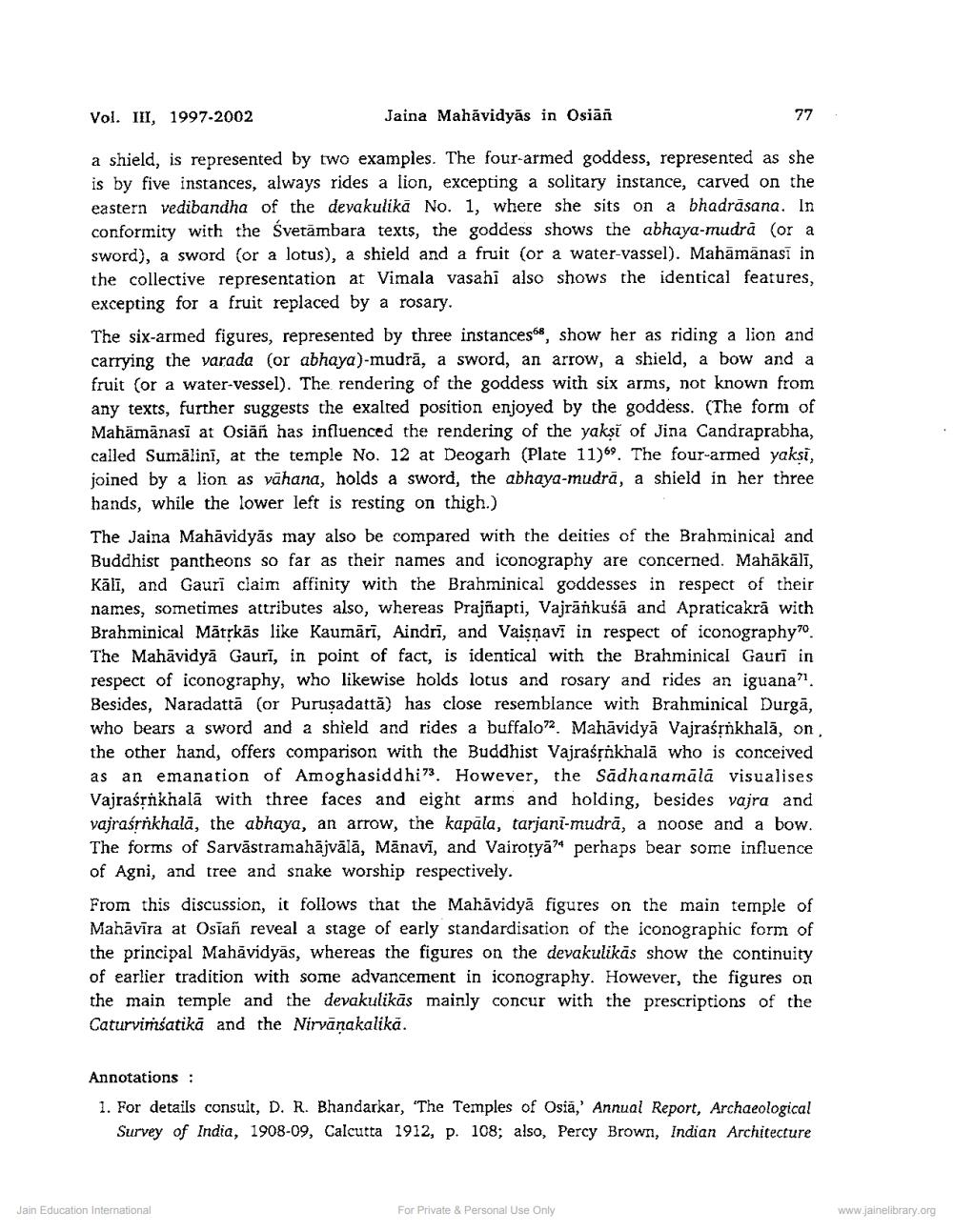Book Title: Jaina Mahavidyas in Osian Author(s): Maruti Nandan Prasad Tiwari, Kamalgiri Publisher: Z_Nirgrantha_1_022701.pdf and Nirgrantha_2_022702.pdf and Nirgrantha_3_022703.pdf View full book textPage 8
________________ Vol. III, 1997-2002 Jaina Mahavidyās in Osian a shield, is represented by two examples. The four-armed goddess, represented as she is by five instances, always rides a lion, excepting a solitary instance, carved on the eastern vedibandha of the devakulikā No. 1, where she sits on a bhadrasana. In conformity with the Svetämbara texts, the goddess shows the abhaya-mudra (or a sword), a sword (or a lotus), a shield and a fruit (or a water-vassel). Mahāmānasī in the collective representation at Vimala vasahi also shows the identical features, excepting for a fruit replaced by a rosary. 77 The six-armed figures, represented by three instances, show her as riding a lion and carrying the varada (or abhaya)-mudra, a sword, an arrow, a shield, a bow and a fruit (or a water-vessel). The rendering of the goddess with six arms, not known from any texts, further suggests the exalted position enjoyed by the goddess. (The form of Mahāmānasī at Osian has influenced the rendering of the yakși of Jina Candraprabha, called Sumālinī, at the temple No. 12 at Deogarh (Plate 11). The four-armed yakṣi, joined by a lion as vähana, holds a sword, the abhaya-mudra, a shield in her three. hands, while the lower left is resting on thigh.) The Jaina Mahavidyās may also be compared with the deities of the Brahminical and Buddhist pantheons so far as their names and iconography are concerned. Mahākālī, Käll, and Gauri claim affinity with the Brahminical goddesses in respect of their names, sometimes attributes also, whereas Prajñapti, Vajrāñkuśā and Apraticakra with Brahminical Matṛkās like Kaumārī, Aindri, and Vaisnavi in respect of iconography. The Mahavidya Gaurī, in point of fact, is identical with the Brahminical Gauri in respect of iconography, who likewise holds lotus and rosary and rides an iguana". Besides, Naradatta (or Purusadattă) has close resemblance with Brahminical Durgā, who bears a sword and a shield and rides a buffalo". Mahavidya Vajraśṛnkhalā, on, the other hand, offers comparison with the Buddhist Vajrasṛnkhala who is conceived as an emanation of Amoghasiddhi". However, the Sadhanamālā visualises Vajrasṛnkhala with three faces and eight arms and holding, besides vajra and vajraśrnkhald, the abhaya, an arrow, the kapala, tarjani-mudra, a noose and a bow. The forms of Sarvästramahājvālā, Mānavī, and Vairotya" perhaps bear some influence of Agni, and tree and snake worship respectively. From this discussion, it follows that the Mahavidya figures on the main temple of Mahāvīra at Osian reveal a stage of early standardisation of the iconographic form of the principal Mahavidyas, whereas the figures on the devakulikäs show the continuity of earlier tradition with some advancement in iconography. However, the figures on the main temple and the devakulikās mainly concur with the prescriptions of the Caturviṁsatikā and the Nirvanakalikā. Annotations : 1. For details consult, D. R. Bhandarkar, 'The Temples of Osia,' Annual Report, Archaeological Survey of India, 1908-09, Calcutta 1912, p. 108; also, Percy Brown, Indian Architecture Jain Education International For Private & Personal Use Only www.jainelibrary.orgPage Navigation
1 ... 6 7 8 9 10 11 12 13 14 15 16 17 18 19 20
